原标题:日粮添加丁酸甘油酯可调节肉鸡的肠道微生物群组成和血清代谢物
Dietary butyrate glycerides modulate intestinal microbiota composition and serum metabolites in broilers
作者:Xiaojian Yang1, Fugui Yin1,2, Yuhui Yang3, Dion Lepp1, Hai Yu1, Zheng Ruan4, Chengbo Yang5, Yulong Yin2,4,6, Yongqing Hou6, Steve Leeson7 & Joshua Gong1
1Guelph Research and Development Centre, Agriculture and Agri-Food Canada, Guelph, Ontario, N1G 5C9, Canada.
2 Institute of Subtropical Agriculture, Chinese Academy of Sciences, Changsha, Hunan, 410125, China.
3 The Laboratory of Food Nutrition and Functional Factors, School of Food Science and Technology, Jiangnan University, Wuxi, Jiangsu, 214122, China.
4State Key Laboratory of Food Science and Technology, Nanchang University, Nanchang, Jiangxi, 330047, China.
5 Department of Animal Science, University of Manitoba, Winnipeg, Manitoba, R3T 2N2, Canada. 6Hubei Key Laboratory of Animal Nutrition and Feed Science, Wuhan Polytechnic University,
Wuhan, Hubei, 430023, China.
7 Department of Animal Biosciences, University of Guelph, Guelph, Ontario, N1G 2W1, Canada
来源:SCIENTIFIC REPORTS | (2018) 8:4940 | DOI:10.1038/s41598-018-22565-6
翻译:肠动力研究院 梁琦
【摘要】丁酸已被证明可调节机体免疫应答、能量消耗和增强动物肠道健康的作用。但当前关于丁酸对肠道微生物群的生态学、血清代谢物的整体特征以及它们之间联系的影响知之甚少。本文旨在通过基于细菌16S rRNA基因的焦磷酸测序和核磁共振(NMR)代谢分析来探究喂食丁酸甘油酯(BG,含有3000ppm丁酸)对青年肉鸡的肠道微生物群组成和血清代谢物变化的影响。48羽1日龄的Ross308肉用仔鸡被随机分成两组,1)对照组(BD):饲喂基础日粮;2)丁酸甘油酯组(BG):喂食基础日粮+3000ppm丁酸甘油酯的混合物和/或单丁酸甘油酯,每组24羽,每组6个重复,试验为期20天。试验结束后,通过NMR代谢分析技术、包括细菌16S rRNA基因的焦磷酸测序在内的宏基因组学技术、q-PCR技术、对部分肉鸡的血清和盲肠与回肠的食糜展开分析。结果显示,喂食BG日粮不会影响肠道微生物群的α多样性,但可改变其组成。此外还鉴定了对照组和BG处理组肉鸡之间盲肠微生物群的39个关键操作分类单位(OTU)。尤其是双歧杆菌受到含有BG日粮处理的显著影响,不仅显示其丰度增加(约3倍,P≤0.05),而且物种多样性也增加。基于NMR的分析显示BG组肉鸡血清中的丙氨酸,低密度和极低密度脂蛋白和脂质(P≤0.05)的浓度相应增加。更有趣的是,BG处理也提高了(P≤0.05)血清细菌代谢物的浓度,包括胆碱,甘油磷酸胆碱,二甲胺,三甲胺,三甲胺-N-氧化物,乳酸和琥珀酸。总之,研究结果表明,1)日粮添加BG可调节肉鸡的肠道微生物群和血清代谢物;2)肠道细菌(双歧杆菌)对肉鸡脂质代谢/能量的稳态具有潜在贡献。
以下是相关图表
图1:丁酸甘油酯对回肠微生物群β-多样性的影响。基于未加权的UniFrac距离的PCoA的二维图(B)ANOSIM基于微生物群落之间未加权的UniFrac的距离;(C)BD:基础日粮; BG:BD :BD上添加丁酸甘油酯
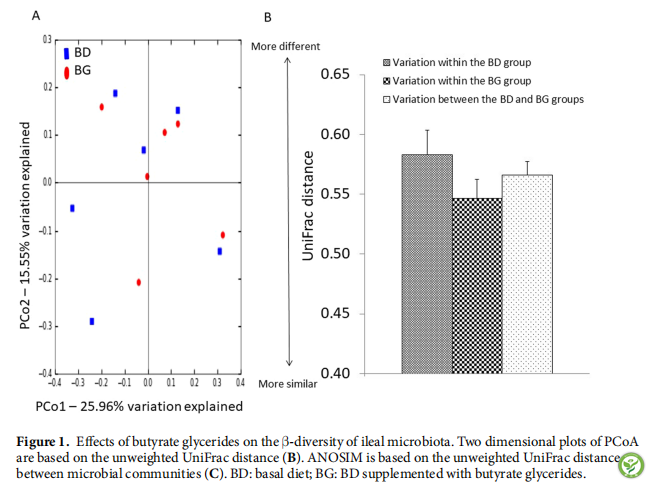
图2:丁酸甘油酯对盲肠微生物群β-多样性的影响。基于未加权的UniFrac距离的PCoA的二维图(B)ANOSIM基于微生物群落之间未加权的UniFrac的距离;(C)BD:基础日粮; BG:BD上添加丁酸甘油酯

表1:关键OTU用于区分BD和BG喂养的鸡之间的盲肠微生物特征。通过PLS-DA分析确定。BD:基础饮食; BG:BD饮食补充丁酸甘油酯。
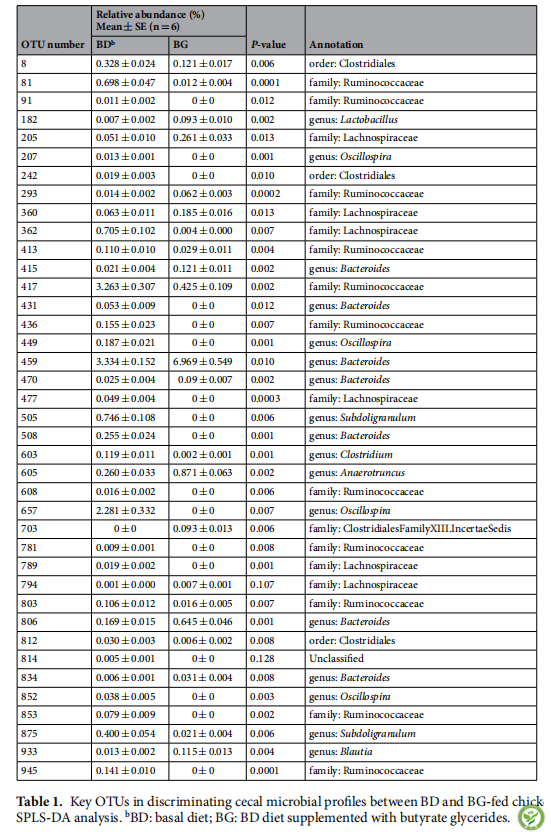
图3:在盲肠微生物群中鉴定的关键OTU的热图。通过SPLK-DA将OTU鉴定为用于区分BG处理和未处理(BD)组的盲肠微生物群中的微生物谱的关键变量。基于16S rRNA序列的百分比组成由颜色强度指示。N = 6; 1,2,3,4,5,6:肉鸡的数量。颜色键值表示OUT的相对丰度,表示为单个肉鸡的序列总数的百分比。
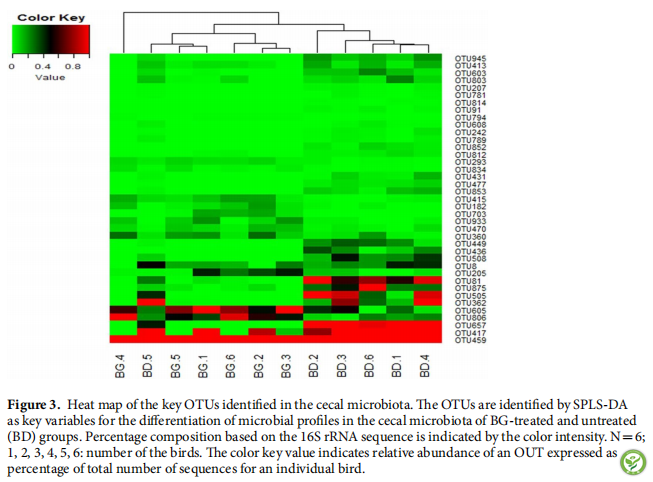
表2:通过q-PCR确定的所选盲肠细菌群丰度的倍数变化.BD:喂食基础日粮的肉鸡。BG:鸡饲喂BD基础上添加丁酸甘油酯的日粮。

表3:血清代谢物的分布。注:GPC,甘油磷酸胆碱; LDL,低密度脂蛋白; VLDL,极低密度脂蛋白; TMAO,三甲胺N-氧化物。
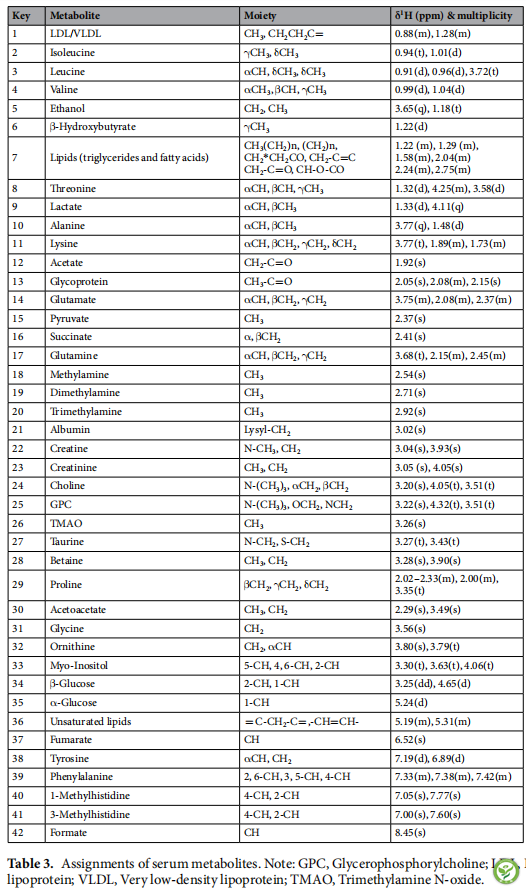
图4:使用SIMCA-P 13.0进行模式识别。PCA评分图(A),PLS-DA评分图(B),PLS-DA验证图(置换数:200)(C),以及OPLS-DA评分图(D)与BD组肉鸡相比,来自BG组肉鸡的1H NMR血清光谱。BG喂养和BD喂养的肉鸡之间相应的S-图,表明代谢物显著变化(图E):1,LDL / VLDL; 2,脂类; 3,乳酸; 4,丙氨酸; 5,琥珀酸; 6,二甲胺;7,三甲胺; 8,胆碱; 9,GPC; 10,TMAO。
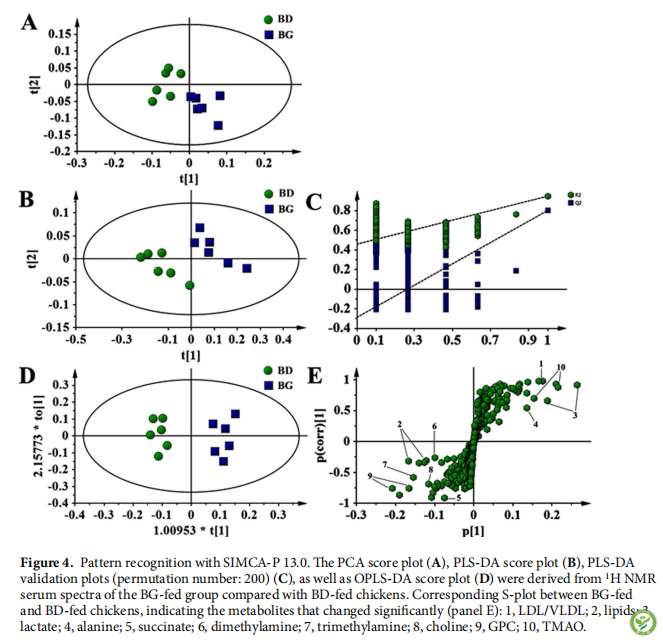
表4:丁酸甘油酯对血清代谢物相对浓度的影响。注:GPC,甘油磷酸胆碱; LDL,低密度脂蛋白; VLDL,极低密度脂蛋白; TMAO,三甲胺N-氧化物。aFC:BG和BD饮食喂养组之间的倍数变化;b投影中的变量重要性(VIP≥1)是从OPLS-DA分析中获得的。cP值由Student's t检验确定。↑:含有识别代谢物的区域的积分值相对增加。
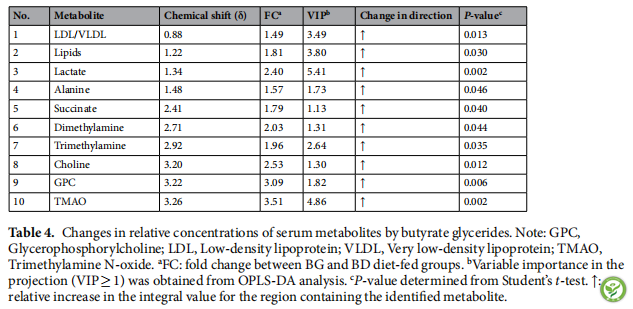
结论
研究结果表明,1)日粮添加BG可调节肉鸡的肠道微生物群和血清代谢物;2)肠道细菌(双歧杆菌)对肉鸡脂质代谢/能量的稳态具有潜在贡献。
Abstract
Butyrate can modulate the immune response and energy expenditure of animals and enhance intestinal health. The present study investigated changes in the intestinal microbiota composition and serum metabolites of young broilers in response to 3,000 ppm butyrate in the form of butyrate glycerides (BG) via pyrosequencing of bacterial 16S rRNA genes and nuclear magnetic resonance (NMR). The dietary treatment did not afect the alpha diversity of intestinal microbiota, but altered its composition. Thirty-nine key operational taxonomic units (OTUs) in diferentiating cecal microbiota community structures between BG treated and untreated chickens were also identifed. Bifdobacterium was, in particular, afected by the dietary treatment signifcantly, showing an increase in not only the abundance (approximately 3 fold, P≤0.05) but also the species diversity. The (NMR)-based analysis revealed an increase in serum concentrations of alanine, low-density and very low-density lipoproteins, and lipids (P≤0.05) by BG. More interestingly, the dietary treatment also boosted (P≤0.05) serum concentrations of bacterial metabolites, including choline, glycerophosphorylcholine, dimethylamine, trimethylamine, trimethylamine-N-oxide, lactate, and succinate. In conclusion, the data suggest the modulation of intestinal microbiota and serum metabolites by BG dietary treatment and potential contribution of intestinal bacteria to lipid metabolism/energy homeostasis in broilers.
Conclusion
In conclusion, the data suggest the modulation of intestinal microbiota and serum metabolites by BG dietary treatment and potential contribution of intestinal bacteria to lipid metabolism/energy homeostasis in broilers.
如您需原文,请联系本文作者和出版方,或请垂询肠动力研究院。本网站发布的所有资料将尽最大可能注明出处、作者及日期,如无意中侵犯了您的知识产权,请来信及时告知,我们将立即予以删除。
All information released by the WeChat Official Account will do its best to indicate the source, author and date. If we inadvertently infringe on your intellectual property, please inform us in time and we will delete it immediately.







